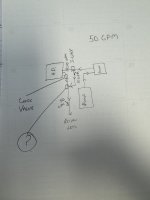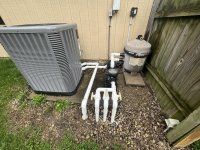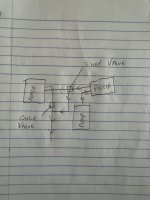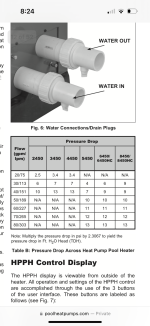I have a Raypak 8450 HP. It works great but it is relatively restrictive. It seems like even though it has a titanium heat exchanger and does not call for a bypass, that a bypass is still a good thing to have. According to the manual it looks like I’m probably getting 9-10 on the pressure drop and I’m not going to be using the HP the vast majority of the time. So I want to install a bypass. I attached what I believe to be the best way, but I would like feedback please to make sure I’m thinking correctly. I realize I’m going to have to change my 45s from the filter to the HP to 90s to give room for the 3 way. Then run a T at an angle to line up with the 90 that will be on the bypass line. Question 2 is, with this could you partially bypass the HP? Let’s say I wanted to heat and run the pump on high to mix chemicals and keep the flow rate to the HP optimal. TIA
Best way to bypass heater
- Thread starter hammer64
- Start date
You are using an out of date browser. It may not display this or other websites correctly.
You should upgrade or use an alternative browser.
You should upgrade or use an alternative browser.
You have the right concept on the bypass. This is the Wiki for it if you need to read more
 www.troublefreepool.com
www.troublefreepool.com
If the bypass is partially open then it will take longer to heat the water.
Heater Bypass - Further Reading
If the bypass is partially open then it will take longer to heat the water.
- Jan 7, 2012
- 2,123
- Pool Size
- 21000
- Surface
- Plaster
- Chlorine
- Salt Water Generator
- SWG Type
- Pentair Intellichlor IC-60
Your sketch looks good. The bypass significantly improves the efficiency of your system when you're not using the HP. Use a high quality three-way diverter and check valve (Jandy or Pentair).
I don't see a chlorinator in your system. Are you manually dosing? Fill out your signature when you have a minute.
While you're replumbing, I'd recommend replacing the three ball valves with high quality 2-way diverters (and a 3-way diverter at the T if it makes sense).
When you're using the HP, the bypass should be completely closed under normal circumstances. What kind of circulation pump do you have?Question 2 is, with this could you partially bypass the HP? Let’s say I wanted to heat and run the pump on high to mix chemicals and keep the flow rate to the HP optimal.
I don't see a chlorinator in your system. Are you manually dosing? Fill out your signature when you have a minute.
While you're replumbing, I'd recommend replacing the three ball valves with high quality 2-way diverters (and a 3-way diverter at the T if it makes sense).
Sorry for the late response.Your sketch looks good. The bypass significantly improves the efficiency of your system when you're not using the HP. Use a high quality three-way diverter and check valve (Jandy or Pentair).
When you're using the HP, the bypass should be completely closed under normal circumstances. What kind of circulation pump do you have?
I don't see a chlorinator in your system. Are you manually dosing? Fill out your signature when you have a minute.
While you're replumbing, I'd recommend replacing the three ball valves with high quality 2-way diverters (and a 3-way diverter at the T if it makes sense).
I have a Hayward tristar VS pump.
I just add liquid chlorine every other day.
Just to clarify, you think it would be a good idea to replace the 3 inlet valves and plumbing while I’m at it?
Thanks
I forgot to ask one thing. On the by pass line that will need a T going into the return line, is there a swept T of some sort to use?
Thanks!
Thanks!
- May 27, 2021
- 1,290
- Pool Size
- 17000
- Surface
- Fiberglass
- Chlorine
- Salt Water Generator
- SWG Type
- Pentair Intellichlor IC-40
If your pump supplies over 80 gpm an external bypass is recommended, and the flow to the heater when setting the bypass should be a minimum of 30 gpm for your model HP.Question 2 is, with this could you partially bypass the HP?
There are pressure rated long sweeps available, but you will likely have to order them. Big box store don’t have them for pressure, only DWV. The difference will be negligible if it’s the only long sweep in the system.On the by pass line that will need a T going into the return line, is there a swept T of some sort to use?
- Jan 7, 2012
- 2,123
- Pool Size
- 21000
- Surface
- Plaster
- Chlorine
- Salt Water Generator
- SWG Type
- Pentair Intellichlor IC-60
Yes. Those ball valves are junk and will eventually fail. There are unions, so you can disconnect and build a new suction manifold with quality diverter valves.Just to clarify, you think it would be a good idea to replace the 3 inlet valves and plumbing while I’m at it?
Never Lube Jandy Valve: Jandy Pro Series Valve | Jandy
Looking for a Never Lube Jandy Valve? Find this Jandy Pro Series Valve for the Perfect Pool Experience. Buy Now w/ a Pool Pro Near You!
 www.jandy.com
www.jandy.com
So I uploaded what is basically my question. I’m just trying to understand how the flow would work. I’m putting a by pass in for the heat pump. That makes sense and is easy for me to understand. I’m having trouble understanding how a partial bypass would work. My example, is only just numbers I’m not saying this is what I want to do. So let’s say the pump is pulling 50 gpm and I want 40 gpm to go to the heat pump and I want to by pass 10 gpm. At the T intersection where the 40 and 10 gpm meet, how dies that work? Does that just create pressure and force water back towards the 3 way and create an environment where it is working against itself. Or does that 10 gpm just jump on board with the 40 gpm moving? I’m trying to understand and can’t seem to find an answer. Thanks!


- Jul 21, 2013
- 65,120
- Pool Size
- 35000
- Surface
- Plaster
- Chlorine
- Salt Water Generator
- SWG Type
- Pentair Intellichlor IC-60

Bernoulli's principle - Wikipedia
The 10 GPM combines smoothly with the 40 GPM and the flow changes to 50 GPM.
They are fluids.
I tried to read and understand that, but I was unsuccessful lol. So basically what I drew up works? I guess that’s all I need to know, even if I don’t fully grasp the concept totally. I appreciate the response
Bernoulli's principle - Wikipedia
en.wikipedia.org
The 10 GPM combines smoothly with the 40 GPM and the flow changes to 50 GPM.
They are fluids.
- Jul 21, 2013
- 65,120
- Pool Size
- 35000
- Surface
- Plaster
- Chlorine
- Salt Water Generator
- SWG Type
- Pentair Intellichlor IC-60
If I opened up the 3 way partially I don’t want the system to work against itself. Let’s say I’m mixing chemicals in the pool and want to speed up the process by turning the pump up, it’s variable speed. I would by pass some of the water around the heat pump to not get above the recommended 80 gpm according to the manual. When I look at it, obviously I don’t understand fluid dynamics. It seems possible that the out from the heat pump would travel to the return jets and down the T towards the 3 way. At the same time water is trying to come out the 3 way towards to return jets. So I pictured them pushing against each other. Which seems like a bad thing
- Jul 21, 2013
- 65,120
- Pool Size
- 35000
- Surface
- Plaster
- Chlorine
- Salt Water Generator
- SWG Type
- Pentair Intellichlor IC-60
Perfect. Thanks for the prompt response. And thanks Bernoulli who him and you are obviously smarter than me, lol. Seriously thanks. I didn’t want to mess things up.It doesn't work that way.
Bernoulli figured it out for you.
I think I understand finally. The return lines going to the pool are going to be lower pressure than just about any amount of water coming from the heat pump or the by pass or BOTH because of the pressure from the pump. Therefore the water is going to flow to the pool. Do I have the science correct there?
- Feb 6, 2015
- 7,812
- Pool Size
- 12300
- Surface
- Plaster
- Chlorine
- Salt Water Generator
- SWG Type
- CircuPool RJ-45 Plus
If you have water flowing thru a pipe (100%) and then split it so 80% goes thru one pipe and 20% goes thru a second pipe, once the water is recombined you will have the same quantity of water (100%).
Set the 3-way heater vypass valve as needed. All the water entering the 3-way valve will come out once recombined, no matter how much goes thru each pipe. Water will take the path of least resistance. No way it will flow back into a pressurized feed pipe.
Set the 3-way heater vypass valve as needed. All the water entering the 3-way valve will come out once recombined, no matter how much goes thru each pipe. Water will take the path of least resistance. No way it will flow back into a pressurized feed pipe.
- Jan 7, 2012
- 2,123
- Pool Size
- 21000
- Surface
- Plaster
- Chlorine
- Salt Water Generator
- SWG Type
- Pentair Intellichlor IC-60
Why are you thinking about a "partial bypass"? If you're operating the HP, have the bypass fully closed so all the water flows through the heater. Adjust the VSP RPM to achieve the desired flow (enough to satisfy the flow/pressure switch plus a small margin). If you're adding chemicals, momentarily increase the RPM.I’m having trouble understanding how a partial bypass would work.
I believe when I have the pump on high I’m going to be above the 80 gpm, which is what the manual calls for being the max. So I’m looking to keep it within manufacturing specs.Why are you thinking about a "partial bypass"? If you're operating the HP, have the bypass fully closed so all the water flows through the heater. Adjust the VSP RPM to achieve the desired flow (enough to satisfy the flow/pressure switch plus a small margin). If you're adding chemicals, momentarily increase the RPM.
- Jul 21, 2013
- 65,120
- Pool Size
- 35000
- Surface
- Plaster
- Chlorine
- Salt Water Generator
- SWG Type
- Pentair Intellichlor IC-60
I believe when I have the pump on high I’m going to be above the 80 gpm, which is what the manual calls for being the max. So I’m looking to keep it within manufacturing specs.
There are automatic bypass valves like the AquaCal STK0135 that allow full flow through the heater until the flow reaches the limit and then the bypass opens and routes some water around the heater. AquaCal says:
- When high flow rates are outside recommended specifications, please use this kit or an alternative bypass valve system.
- This kit can be used to control excessive water flow through the heat pump. It provides automatic flow adjustments for most applications.
- Jan 7, 2012
- 2,123
- Pool Size
- 21000
- Surface
- Plaster
- Chlorine
- Salt Water Generator
- SWG Type
- Pentair Intellichlor IC-60
I believe when I have the pump on high I’m going to be above the 80 gpm, which is what the manual calls for being the max. So I’m looking to keep it within manufacturing specs.
You have a VSP. Just lower the RPM and you'll be well below 80 gpm.
Thread Status
Hello , This thread has been inactive for over 60 days. New postings here are unlikely to be seen or responded to by other members. For better visibility, consider Starting A New Thread.




